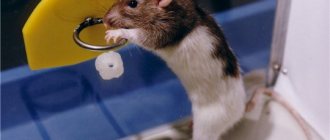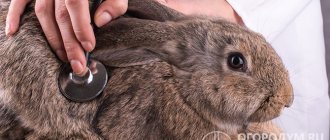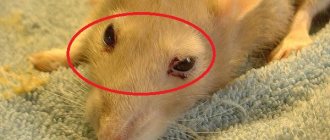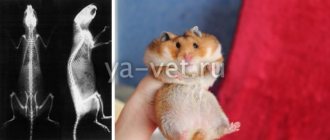IMPORTANT!!! A specialist must diagnose the pathology, identify the cause and treat the rat! If a domestic rat is sick, it is advisable for the owner to urgently contact a veterinary clinic; some diseases of rats are very dangerous for humans: mycoplasmosis, rabies, tuberculosis, toxoplasmosis, tularemia, toxocariasis, rickettsiosis, leptospirosis, hemorrhagic fever, typhus, plague, sodoku, listeriosis.
The rat’s tail has darkened or is peeling, what should I do?
Rats are considered one of the cleanest animals. But their tail is a part of their body that can sometimes get a little dirty. You can tell if a tail is very dirty by looking at the color: if it is darker than usual, it may be time to wash it. If the tail is very dirty, it can also peel off.
Cleaning a rat's tail is quite simple. Simply use a soap and water solution, dip a piece of cloth in it, and wipe the tail. If the tail is very dirty, you can also soak it in a warm solution of soap and water.
When cleaning a rat's tail, be careful. It is better not to suddenly grab animals by the tail. This can frighten them and even traumatize them.
Coming out of anesthesia
The owner can be with the rat as it begins to recover from the anesthesia. Just don't be afraid of its consequences. You need to be prepared for them:
- The rat is vomiting.
- She goes to the toilet on her own. Bowel movements are involuntary.
- The animal becomes aggressive, this is associated with painful sensations.
- Loss of coordination occurs. The rat moves as if in slow motion.
During recovery from anesthesia, be sure to provide your pet with access to drinking water. Many pets become thirsty during this period.
It is necessary to place a clean diaper under the animal. And change it when it gets dirty.
A rat fell from a height, what should I do?
If a rat has fallen from a height, you should first calm the pet down. Do not touch the animal for several minutes, let the rat come to its senses. However, do not lose sight of the rodent. If the pet has not recovered from shock after a long time, inject 0.1 ml of Prednisolone subcutaneously (into the withers) and pour 0.5 ml of Nurofen into the oral cavity to eliminate any discomfort.
Then monitor the rat's behavior for 48 hours. If the animal behaves normally and can move around calmly, then everything is fine with the rodent. However, if your pet begins to limp and lick its tail or limbs, seek help from a veterinary clinic.
Preventive measures
What is the prevention of tumors in pet rats? The owner must comply with the following rules:
- Feed your pet only high-quality food. Calorie content should be low. Forget about purchasing products containing artificial colors and preservatives.
- Buy rats from trusted breeders. Nurseries value their reputation; animals purchased from them are healthy. The likelihood of being given a sick pet is very low.
- It is better to have males, they are less susceptible to cancer than their girlfriends.
- If you notice lumps, bumps, or the symptoms described above, do not hesitate to have your dog examined by a veterinarian. It is easier to prevent a cancerous tumor than to allow it to become inoperable.
My pet has blood in his urine, what should I do?
Seeing blood in a rat's urine is definitely scary. Blood means something is going wrong somewhere in the urinary tract, with many possible causes. Hematuria is not a condition that can go unnoticed by the owner; it needs to be treated immediately. Each potential cause of this dreaded symptom can potentially lead to death if left untreated. Not every condition will cause a rat to meet its untimely death, but it is quite possible if the rat's health is neglected.
The main reasons for the appearance of blood in a pet’s urine:
- Bladder infection
A urinary tract infection can cause blood when you urinate. Severe infections can cause severe damage to the urinary tract, resulting in bleeding. Bleeding indicates a sufficiently advanced infection that requires immediate treatment to save the rat's life.
- Kidney disease or failure
If the kidneys become diseased or begin to fail, they too can cause blood to form in the rat's waste. Severe kidney inflammation may even result in excessive or very little urine output, depending on the condition of the kidneys. Most owners may not know what is normal for their rat, so it is always a good idea to monitor your rat's litter box habits when you suspect the animal may be sick or not feeling well.
- Stones in the kidneys
Just like humans, rats can get kidney stones. As you might have guessed, it's incredibly painful for them too. As kidney stones travel from the kidney to the bladder and out the urethra, they can cause some damage. Rats with kidney stones need to be given antibiotics to prevent the damage from leading to infection. Poor diet may also be a major cause.
- Worms in the bladder
Threadworms are highly invasive parasites that can destroy a rat's bladder and ultimately kill it. Antiparasitic drugs will be needed here. If the worms are not killed, the rat's health will only deteriorate. In addition, any other rats that share the cage with the infected rat will need to be treated. It's almost a promise that other rats are also infected to some degree.
- Tumors and cancers
Unfortunately, rats can develop cancer of the urinary tract. Most often it is kidney cancer or bladder cancer. Other neoplasms and tumors can also affect the urinary system, especially in later stages. Any tumor in a body cavity can grow large enough to shut down the kidneys or the entire urinary system. In this case, the rat should be euthanized when the quality of life deteriorates significantly.
The best way to get rid of blood is to eliminate the cause of the bleeding. A rat will not urinate blood for no reason. Instead, there is something that is causing damage to the urinary tract. Any bacterial infection will require rat-safe antibiotics.
In case of inflammation, steroids and anti-inflammatory drugs may be prescribed. This will reduce swelling, preventing the organ or tissue from causing more harm to itself, and as a result, reduce pain. Bacterial infections will require one of a variety of antibiotics, depending on what pathogen is causing the infection. When it comes to pain, such as kidney stones or tumors, painkillers such as Metacam can significantly improve the quality of life of a sick rat.
Signs of a tumor
What are the symptoms of tumors in pet rats? We publish a detailed list so that an attentive owner can notice the problem at an early stage of its occurrence:
- The mucous membranes become gray.
- Excessive urination and bowel movements occur.
- The pet secretes blood from the vagina, anus, urethra, and mouth.
- Hernias appear.
- The rat becomes lethargic and has no appetite.
- The pet begins to go bald. The fur is disheveled and unpleasant to touch.
- Lumps appear on the body, which can be easily felt when touched.
- Hard growths on the animal's body are possible.
If the rat owner detects such signs, then it is necessary to urgently consult a veterinarian.
The rat choked, what should I do?
Choking is a painful act that occurs mainly due to negligence. This is a life-threatening situation because in this situation the airway is blocked. This condition is usually caused by food particles. Food, instead of getting into the proper path it should take, will move towards the respiratory tract, which causes suffocation. If you don't act quickly, it can be fatal to the rat.
To prevent the possibility of food getting stuck in the animal’s throat, it is necessary to develop a safe diet for the rodent. If a rat chews its food incorrectly, choking may occur. Thus, the diet should only include food that the pet can easily chew and swallow very easily.
If your rat is choking, you can prevent choking using the following methods:
- Turning over the animal
This is the easiest way to immediately remove the choking hazard. The owner needs to turn the rodent's body over and bend it slightly. In such a way that you can press his chest with your palm. It is necessary to press on the chest with very careful movements. Chest compression helps the pet clear the object from the airway so it can be saved.
- Use a cotton swab
Using a cotton swab, you can remove the object from the rat's respiratory tract. In this method, a stick is inserted into the throat through the mouth. Such a stick can penetrate deep into the throat and pull out an object.
- Operation
This method is very critical and risky. Specialists make an incision in the neck to remove the foreign object from the airway. If the previous two methods did not work, then this is the last method that can save your pet's life. The operation can only be successful if it is performed on time.
Birth of the brood
After giving birth, the rat can eat the entire litter, experiencing stress! To prevent this from happening, you should:
- do not touch or look at babies;
- do not touch the female;
- remove play accessories from the cage;
- put paper napkins in the cage;
- There is no need to clean the home, you can only pick up heavily soiled pieces of napkins so as not to accidentally destroy the nest;
- Monitor the availability of food and water.
The number of offspring may depend on the species to which the female belongs; for convenience, consider the table:
| View | Duration of pregnancy | Duration of the lactation period | Number of litters | Number of cubs |
| White rat | 20-25 | 21-23 | 5 | up to 20 |
| Gray rat | 20-25 | 22-23 | 5 | up to 20 |
| Black rat | 20-25 | 22-24 | 5 | up to 7 |
Caring for newborn rat pups
It happens that the female does not care for newborn rats, there are several reasons for this: the litter is too large, or if the cub cannot get to the milk, as well as other reasons. In this case, caring for the little rats falls on the owner.
During the first days there is no need to touch the mother and babies, but after a while you can start getting to know the offspring. According to the advice of experienced rat breeders, if the newborns are introduced to each other before they open their eyes, then the rats grow up to be very outgoing and sociable.
For the first couple of weeks, newborn rat pups eat only their mother's milk. Rats older than this age begin to show interest in solid foods and begin to understand tastes.
What to feed baby rats
Let's look at the feeding table for newborns by week:
| 1st week | 2nd week | 3rd week | 4th week |
| mother's milk or formula every 2-3 hours | mixture with grain feed, every 4 hours and once at night | the mixture with grain feed is poured into a bowl, night feeding is canceled | switching to dry food |
Also, up to 6 weeks of age, drinking cow's or goat's milk using a pipette is allowed. If the female feeds the babies with breast milk, then from the age of one month they, together with their mother, switch to regular food; the following can be added to the diet of newborns:
- dairy products;
- fruits;
- candied fruits, etc.
Artificial feeding of rat pups
If it happens that a rat refuses to feed newborns, you need to be prepared for the fact that feeding is a rather complicated process. It is best to use another lactating rat for this; if this is not possible, then the babies are fed with baby formula or a milk replacer. For convenience, use a pipette or insulin syringe. After each feeding, all items must be sterilized.
The rat began to hiccup frequently, what should I do?
Rat hiccups are not exactly like human hiccups. If your rat rarely hiccups, then this is normal. But in any other case, it could be a sign of respiratory problems and lead to something serious.
Hiccups are an involuntary spasm of the diaphragm muscle. As a natural reflex, the vocal cord closes, resulting in the characteristic human sound of hiccups. But when it comes to rats, the sound cannot be heard. But you can notice rhythmic twitching of the body.
There are several ways to find out if your rat's hiccups can be simply ignored or if you need to take serious action. The first way is to check whether the animal's hiccups have a sound. Normal hiccups in rats are silent. If hiccups are accompanied by a squeaking sound, this may be a sign of a respiratory problem.
Another way to tell if a rat's hiccups can be ignored is to see if they continue to move between hiccups. If they do this, it is a sign that the hiccups are a passing phenomenon. If instead they stay in one place (usually in a corner) while they do this, then this is a sign of something more serious. In this case, you should consider taking your rat to the vet for a full examination.
Under normal conditions, rats hiccup as a result of excitement. This can happen while playing or while eating. Although some rats hiccup when they are upset or angry, hiccups are mostly associated with positive feelings of arousal.
But in more serious cases, rat hiccups may be a symptom of active Myco pulmonis, a certain bacteria that pet rats are infected with from birth. Some researchers even believe that any hiccups in rats are due to Myco pulmonis infections.
Most veterinarians will recommend some kind of antibiotic for this condition, such as Baytril (2 mg/tablet for rats) and Doxycycline for 2-6 weeks. Most rats recover by this time and the hiccups go away.
All rats are born with a predisposition to Myco infection and will show symptoms (such as hiccups) every now and then. Some rats show symptoms more often than others. If you follow all the recommendations of experts, your furry friend will recover in no time.
Bone tissue injuries
The most common injury is a broken tail in a rat, which occurs as a result of being pinched by a cage door. It is not uncommon for owners or family members to unintentionally step on a rodent.
Veterinarians are confident that if a rat breaks its tail and is examined by a specialist in time, breeders can rest assured. Typically, the broken part must be amputated, but in rare cases the animal may chew it off. If a wound is found on the tail, the area is treated with a weak solution of potassium permanganate.
If the owner accidentally steps on a rat and the animal is injured, it is important to act quickly:
- place the animal on a flat surface;
- if a rodent has broken its spine, it will drag its hind legs;
- when an animal drags one paw, then we are talking about a fracture of the limb.
The exact type of damage is only visible on x-rays. If a spinal fracture is suspected in a rat, the rodent is placed in a small box and covered with cotton wool. If an animal has a broken leg, it is permissible to apply a splint made from a flat stick above the fracture site.
After initial measures, it is necessary to take an x-ray of the rat’s paw fracture so that the doctor can make an accurate diagnosis.
How to inject a rat yourself?
To safely administer the injection, the animal must be restrained. This will require two people. Rats are generally docile animals, especially if they are handled regularly using appropriate methods. Rat bites are rare and usually only happen when the animal is stressed or in pain. To hold the rat, one person should gently grab it by the shoulders.
The thumb can then be placed under the rat's lower jaw to prevent biting, and the rat's hind legs can be supported with the other hand. The restriction should be tight, but not too tight, as this will interfere with the animal's breathing.
To administer the medicine subcutaneously to an animal, you need to wrap two fingers around the back of the rat's neck and insert a needle into this area, slowly injecting the solution. With the intramuscular method, a syringe is inserted into the fleshiest part of the thigh.
Sleep phases
There is a resting phase and a dreaming phase.
The fact that these different conditions were suspected at the end of the 20th century, when they learned to write an electroencephalogram (EEG) well. EEG is the total electrical activity of the nerve cells of the cerebral cortex; in order to record it, you need to attach sensors to your head in certain places:
α-rhythms, β-rhythms, δ-rhythms, θ-rhythms were identified. It turned out that different phases of sleep are characterized by different rhythms.
,
EEG is the total electrical activity of nerve cells, and for it to be beautiful, the cells must work synchronously, i.e. stand idle Beautiful waves on the EEG are an idle state of neural networks, when there is no specific information, but a certain neural circuit is in a state of readiness.
Alpha rhythms were the first to be discovered; their frequency reflects the active functioning of our sensory systems. The sensory systems are actively working, but there are no real visual or auditory signals. When a person is in a state of quiet wakefulness
- sits with his eyes closed and does nothing - we will record a beautiful alpha rhythm.
Beta rhythms are faster, their frequency reflects the transmission of a signal within the cortex of more hemispheres - mental load. You were just thinking about something difficult and then you relaxed. At this moment you can record a beautiful beta rhythm.
If most nerve cells are engaged in specific tasks, no waves are visible at all. A low-amplitude, almost flat curve is written. The rarer the waves and the larger their amplitude, the lower the brain activity.
Theta and delta rhythms are written when the brain increasingly enters a sleepy state.
Theta rhythm is about falling asleep.
Delta rhythm - interaction with deep sleep centers. This is the state of rest.
During the transition from wakefulness to sleep, the waves on the EEG become more rare and high-amplitude.
In the alpha rhythm there are 10-12 waves per second, and in falling asleep there are already 1-2 waves. The presence of delta waves indicates a state of sleep/rest.
If an adult has delta waves while awake, this may indicate the occurrence of a tumor, for example.
If you continuously write an EEG during sleep, the delta rhythm of sleep is replaced by a strange picture. The person continues to sleep, sometimes it is even more difficult to wake him up during this phase, but a rhythm appears on the EEG, as if the brain is actively processing information. Not just alpha and beta waves, but sometimes almost flat pieces.
The paradox is that a person is asleep, but the brain is awake. So this phase of sleep was called “paradoxical sleep.” It is also called the “rapid eye movement” phase, REM sleep, or “rapid eye movement” REM sleep.
If a person is awakened during this phase, he will often say that he was dreaming.
It gradually became clear that during this phase, a person processes accumulated information. A clear division appeared: sleep-rest, and sleep-dreams. And the purpose of a dream is the processing of accumulated information.
The most important picture of the entire lecture:
The columns are one full human dream. Horizontal time in hours. Green color is delta sleep or slow wave sleep. Red bars - REM sleep.
The duration of the cycles is about 1.5 hours. The ratios of delta sleep and REM sleep change. In the beginning, the first 2 cycles, it is more important to rest. Afterwards, the brain focuses more on processing the accumulated information, not only fresh and relevant information.
Can drive a car
The extraordinary nature of these animals is also evidenced by an experiment recently conducted by scientists from the University of Richmond - the team of Professor Kelly Lambert, who built small cars.
The chassis and drivetrain were made from a robot car kit, and a clear plastic food container became the body. Explaining the idea of a steering wheel and pedals to the rats was too difficult. Therefore, management has been simplified. The rat had to stand on the plate and grab the copper rod - due to this, the circuit was closed and the engines turned on.
It's a paradox - but rats learned to drive a car. Three five-minute sessions per week for eight weeks were sufficient. Naturally, treats were also used. It is characteristic that those who had previously lived in a complex environment - multi-level cages with different objects for games - were more trainable.
A rat is taught to drive a car.
arstechnica.com
Melatonin
Melatonin is controlled by the hypothalamus. The release of melatonin is inhibited by visual signals. Even through the eyelids, bright light prevents the pineal gland (the piece of the brain where the black cursor is pointing in the picture) from releasing melatonin.
If your regime is biased towards sleeping during daylight hours, then take care of thick curtains.
Melatonin disperses throughout the body and reduces the activity of all systems: the heart beats slower, intestinal function slows down, and body temperature drops. Plus it is an important antioxidant.
For sleep problems, it is recommended to take melatonin tablets. This substance also has a mild effect, at the level of a dietary supplement. If you often change time zones, understand the importance of melatonin. As you age, problems with melatonin production may arise.











